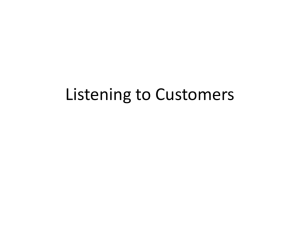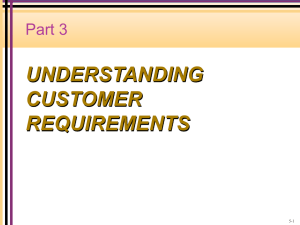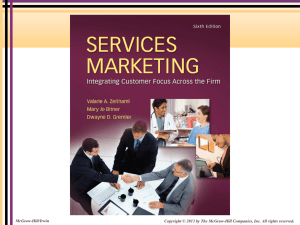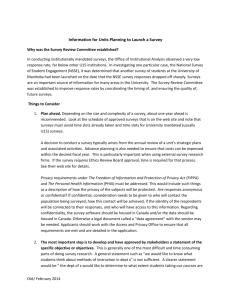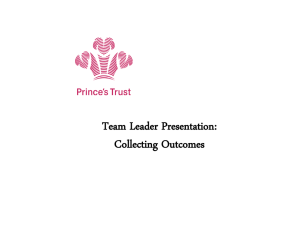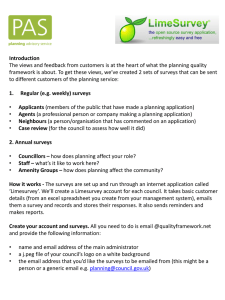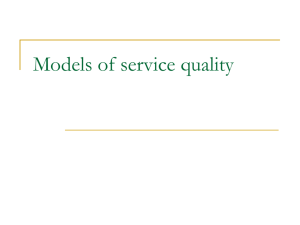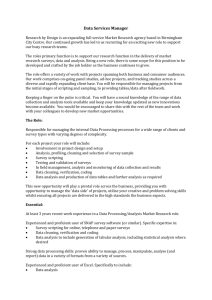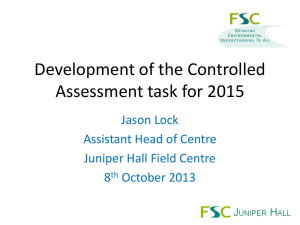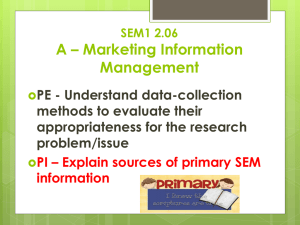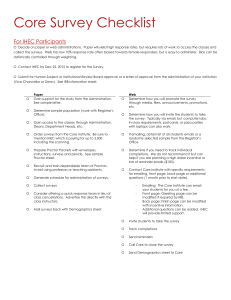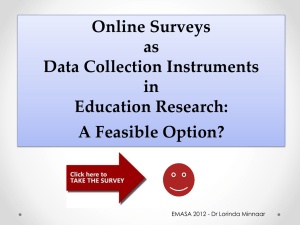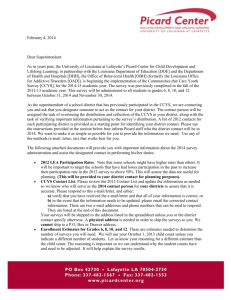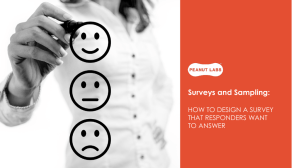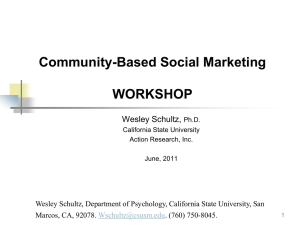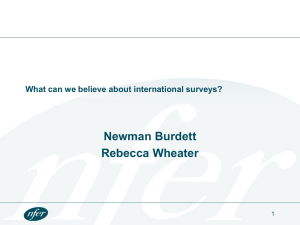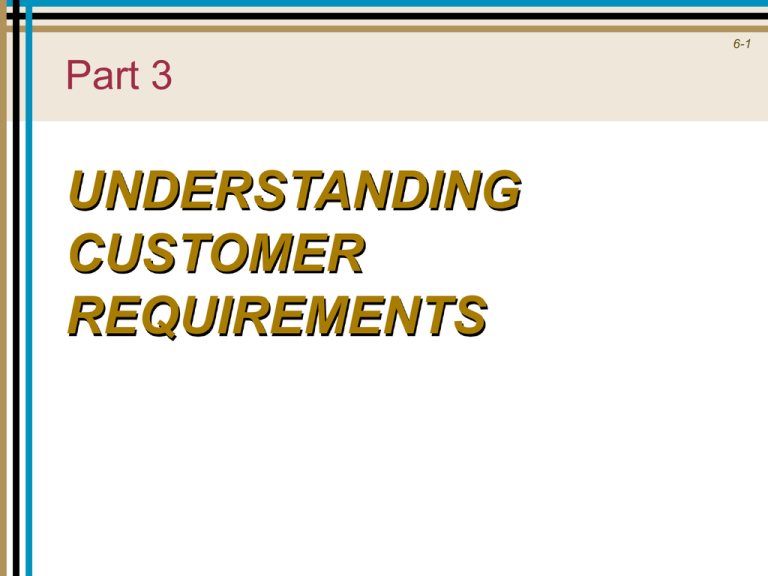
6-1
Part 3
UNDERSTANDING
CUSTOMER
REQUIREMENTS
6-2
Provider Gap 1
6-3
Key Factors Leading to Provider Gap 1
Listening to Customers
through Research
Chapter6-4
6
Using Marketing Research to Understand
Customer Expectations
Elements in an Effective Services Marketing
Research Program
Analyzing and Interpreting Marketing Research
Findings
Model Services Marketing Research Programs
Using Marketing Research Information
Upward Communication
McGraw-Hill/Irwin
Copyright © 2009 by The McGraw-Hill Companies, Inc. All rights reserved.
6-5
Objectives for Chapter 6:
Listening to Customers through Research
Present the types of and guidelines for marketing
research in services.
Show how marketing research information can and
should be used for services.
Describe the strategies by which companies can
facilitate interaction and communication between
management and customers.
Present ways that companies can and do facilitate
interaction between contact people and
management.
Common Research Objectives for
Services
To discover customer requirements or expectations for service.
To monitor and track service performance.
To assess overall company performance compared with that of
competition.
To assess gaps between customer expectations and perceptions.
To identify dissatisfied customers, so that service recovery can be
attempted.
To gauge effectiveness of changes in service delivery.
To appraise the service performance of individuals and teams for
evaluation, recognition, and rewards.
To determine customer expectations for a new service.
To monitor changing customer expectations in an industry.
To forecast future expectations of customers.
6-6
Criteria for an Effective
Service Research Program
6-7
Includes both qualitative and quantitative research
Includes both expectations and perceptions of
customers
Balances the cost of the research and the value of
the information
Includes statistical validity when necessary
Measures priorities or importance of attributes
Occurs with appropriate frequency
Includes measures of loyalty, behavioral
intentions, or actual behavior
6-8
Stages in the (Marketing) Research
Process
STAGE
1:
Define
Problem
and Research
Objectives
STAGE
2:
Develop
Services
Measurement
Strategy
STAGE
3:
STAGE
4:
Implement
Research
Program
Collect
and
Tabulate
Data
STAGE
5:
Interpret
and
Analyze
Findings
STAGE
6:
Report
Findings
Portfolio of Services Research:
Research Is NOT Just Surveys!
Customer Complaint Solicitation
“Relationship” Surveys
Post-Transaction Surveys
Customer Focus Groups
“Mystery Shopping” of Service Providers
Employee Surveys
Lost Customer Research
Critical Service Encounters Research
6-9
6-10
Common means for answering questions
Ask customers directly
mail, phone, face-to-face, online
one-on-one, in groups, formal/informal
Observing customers
anthropological tools, qualitative depth
Get information from employees and front line
service providers
Database marketing research
use customer information files
“capture” behavior through data analysis
10
6-11
Portfolio of Services Research
Research Objective
Type of Research
Identify dissatisfied customers to attempt recovery;
identify most common categories of service failure for
remedial action
Customer Complaint
Solicitation
Assess company’s service performance compared to
competitors; identify service-improvement priorities;
track service improvement over time
“Relationship” Surveys
Obtain customer feedback while service experience is
fresh; act on feedback quickly if negative patterns develop
Post-Transaction Surveys
Use as input for quantitative surveys; provide a forum
for customers to suggest service-improvement ideas
Customer Focus Groups
Measure individual employee service behaviors for use
in coaching, training, performance evaluation,
recognition and rewards; identify systemic strengths
and weaknesses in service
“Mystery Shopping” of
Service Providers
Measure internal service quality; identify employeeperceived obstacles to improve service; track
employee morale and attitudes
Employee Surveys
Determine the reasons why customers defect
Lost Customer Research
Forecast future expectations of customers; develop
and test new service ideas
Future Expectations Research
Tracking of Customer Expectations and
Perceptions of Service Reliability
6-12
Service Quality Perceptions
Relative to Zones of Tolerance
6-13
6-14
Service Quality Perceptions
Relative to Zones of Tolerance
10
8
O
O
O
O
O
6
4
2
0
Reliability
Responsiveness
Computer Manufacturer
Assurance
Empathy
Tangibles
= Zone of Tolerance O = S.Q. Perception
6-15
Importance/Performance Matrix
6-16
Critical Service Encounters Research
Goal:
understanding actual events and behaviors that cause
customer dis/satisfaction in service encounters
Method:
Critical Incident Technique
Data:
stories from customers and employees
Output:
identification of themes underlying satisfaction and
dissatisfaction with service encounters
Sample Questions for Critical
Incidents Technique Study
Think of a time when, as a customer, you had a
particularly satisfying (dissatisfying) interaction
with an employee of ______________.
When did the incident happen?
What specific circumstances led up to this
situation?
Exactly what was said and done?
What resulted that made you feel the interaction
was satisfying (dissatisfying)?
6-17
McDonald’s Creates Health-Conscious
Panel to Do Research and Pass it On
6-18
Mom's Quality Consultants at
McDonalds
Women, especially moms, tend to
get information and form opinions
by talking with others
Selected 6 moms to bring “fully
inside the company”—to visit
restaurants, processing plants,
orchards, and test kitchens
Will keep an online journal for 3
months
Best Buy’s Customer Centric “Lab”
Stores
6-19
Soccer mom:
These stores feature brightly colored signage, play areas for children,
educational toys, and in-wall appliance displays, and provide personal
shopping assistants.
Swinging single:
These stores place greater emphasis on higher-end and more cutting edge
consumer electronics, and feature separate rooms with full home
entertainment vignettes and enhanced A/V assistance.
Cherry picker:
Aimed at technophiles on a budget, these stores offer the most promotions
and incentives, and the best financing packages.
Gadgeteer:
Geared toward teens and twenty-somethings, these stores emphasize cell
phones, music and movies, home theater, gaming, and mobile audio.
Small business:
Signed "Best Buy for Business," these stores have an expanded computer
section and Geek Squad presence, plus central help islands staffed by
associates wearing blue collared (vs. knitted golf) shirts.

